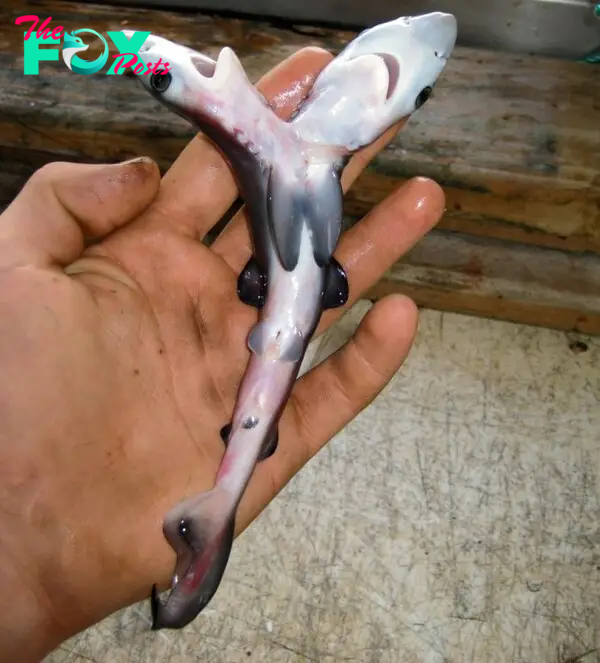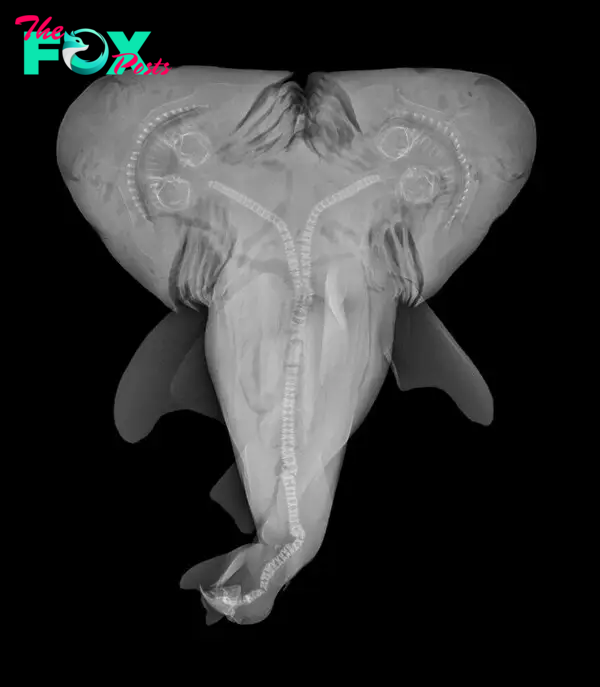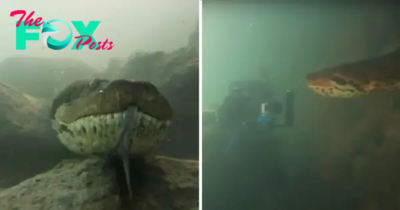Mysterious
AK “Two-headed sharks are increasingly sighted, baffling scientists worldwide as to the cause behind this mysterious phenomenon.”
Two-headed animals? Yeah, they show up in mythology, and in the movies, and we’ve heard a weird thing or two after nuclear disasters like Chernobyl, but that’s it, isn’t it? Well, no. Apparently, more and more two-headed sharks are born all over the world, and scientists are only guessing why.

In 2008, longline fisherman Christopher Johnston was fishing in the Indian Ocean about 200 to 900 miles off West Australia when he hauled aboard a a pregnant blue shark. When he cut open the creature, he discovered a two-headed fetus inside. He decided to share the above photograph after scientists confirmed the discovery of a different two-headed bull shark fetus, off the coast of Mexico.
That other sighting actually occurred only a few years later, in 2013 – around a year after the Deepwater horizon oil spill. A group of Florida fisherman caught a large female bull shark in the Gulf of Mexico, and upon gutting it found that its uterus housed a two-headed fetus. While other species of sharks have been observed being born with two heads, that was the first record of the phenomenon being observed in a bull shark.

Two-headed bull shark fetus found in the Gulf of Mexico. Image credit: Patrick Rice, Shark Defense/Florida Keys Community College
In 2011, an entire study was written about two-headed blue sharks caught in the Gulf of California and off the coast of Mexico. Because females of this species carry the most offspring – up to fifty at a time – they have the highest proportion of two-headed embryos.
Most recently, Spanish researchers discovered a two-headed embryo in the eggs of an Atlantic sawtail catshark in a laboratory study – the first time the abnormality was observed in an egg-laying species. Valentín Sans-Coma, who led the research, believes a genetic disorder may have caused the distortion, although the eggs had not been not exposed to infection, chemicals, or radiation.
In wild sharks, there can be many reasons for the mass appearance of two-headed embryos. Viruses, metabolic disorders, pollution, and inbreeding caused by overfishing may all play a role.

MRI scan of a two-headed bull shark. Some researchers suggest that overfishing may be responsible for the rising numbers of two-headed sharks. As populations dwindle, their gene pool shrinks, giving way to more inbreeding and a rising number of birth defects. Image credit: Michael Wagner/Michigan State University
In another recent study, Nicolas Ehemann, an MA student at the National Institute of Technology in Mexico, examined the two-headed fetuses of a houndshark and a blue shark, the first two-headed specimens to appear in Caribbean waters. He concluded that the most likely cause of distortion was overfishing, and the resulting decline in genetic diversity.
On the other hand, Galván-Magaña, the author of the 2011 study, believes that there aren’t actually more two-headed shark embryos around, only the press is reporting more on them. He says he had seen a lot of weirdness – a few years ago in Mexico, for example, a cyclops shark was caught with a single, perfectly functioning eye at the front of his head. However, such disorders can occur in all animal species, including humans.
Ehemann also admits that shark deformities are not easy to research because there are relatively few specimens available. “It doesn’t work like you throw out the net a few times and catch some double-headed sharks. This is only a coincidence,” the researcher said. “I would like to study these things, but it’s not like you throw out a net and you catch two-headed sharks every so often,” he says. “It’s random.”
We can only hope that such occurrences are indeed incidental, and there’s no underlying pattern (and cause) of increasing sightings.
-

 Mysterious9h ago
Mysterious9h agoFS Delve deeper into the Mystical Beauty of Kandovan Rocky Village
-

 Mysterious15h ago
Mysterious15h agoFS Admire the giant 16th century ‘Colossus’ Sculpture in Florence, Italy complete with hidden rooms inside
-

 Mysterious1d ago
Mysterious1d agoFS Scariest job in the world: Meet the workers building a 3ft wide wooden road on a steep cliff
-

 Mysterious1d ago
Mysterious1d agoFS Incredible Life: A majestic tree thrives on a barren rock despite all odds
-

 Mysterious2d ago
Mysterious2d agoFS A giant whale stranded in the Argentinian forest was discovered by people
-

 Mysterious2d ago
Mysterious2d agoFS Dangerous encounter between the Diver and the amazingly giant Anaconda
-

 Mysterious2d ago
Mysterious2d agoFS Ancient Relic: Monster of the Caspian Sea – A legendary plane rusts on the beach
-

 Mysterious2d ago
Mysterious2d agoFS Explore these small Shops suspended from a large cliff, providing climbers with water and snacks

















